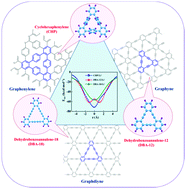Interlocked benzenes in triangular π-architectures: anchoring groups dictate ion binding and transmission†‡
Abstract
Macrocyclic compounds like crown ethers, calixarenes, etc. are well explored in the literature as receptors for alkali metal ions. In most of these studies, the size of the macrocyclic cavity has evolved as the prominent determining criterion for the selective binding of various ions. However, approaches to systematically tailor the ion transport properties via the interplay of topological as well as electronic properties of the hosts are rarely addressed. Herein, we investigate the performance of [2.2.2]PCPs ([2.2.2]paracyclophane and [2.2.2]paracyclophene) and cyclohexaphenylene (CHP) as receptors for the alkali ions, Li+, Na+ and K+. The three macrocycles differ in terms of the groups (ethylene, vinylene and phenylene) anchoring the three benzene rings into triangular three-dimensional architectures, thereby providing opportunities for controlling the topological and the electronic features of the cavities. Based on electronic structure calculations, we predict that PCPs and CHP could be used in conjunction with dehydrobenzoannulenes that possess similar triangular π-architectures in two-dimensions to achieve selective ion transmission. Furthermore, an extended network of CHP, graphenylene, is shown for the first time to be potentially useful in energy storage applications in lithium ion batteries akin to graphyne and graphdiyne. The ion binding properties of graphenylenes would be rather interesting to investigate experimentally for energy applications, particularly in the context of the recent successful synthesis of one of the members of the graphenylene family. Overall, we have attempted to provide a unified description of the cationic interactions with 2D and 3D triangular π-architectures, describing the utility of materials like graphyne, graphdiyne and graphenylene for ion sensing and separation and energy storage applications.



 Please wait while we load your content...
Please wait while we load your content...